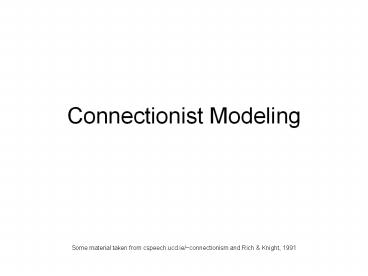Connectionist Modeling - PowerPoint PPT Presentation
Title:
Connectionist Modeling
Description:
Emphasis on learning internal representations automatically. ... excites cell B and repeatedly or persistently takes part in firing it, some ... – PowerPoint PPT presentation
Number of Views:71
Avg rating:3.0/5.0
Title: Connectionist Modeling
1
Connectionist Modeling
- Some material taken from cspeech.ucd.ie/connectio
nism and Rich Knight, 1991
2
What is Connectionist Architecture?
- Very simple neuron-like processing elements.
- Weighted connections between these elements.
- Highly parallel distributed.
- Emphasis on learning internal representations
automatically.
3
What is Good About Connectionist Models?
- Inspired by the brain.
- Neuron-like elements synapse-like connections.
- Local, parallel computation.
- Distributed representation.
- Plausible experience-based learning.
- Good generalization via similarity.
- Graceful degradation.
4
Inspired by the Brain
5
Inspired by the Brain
- The brain is made up of areas.
- Complex patterns of projections within and
between areas. - Feedforward (sensory -gt central)
- Feedback (recurrence)
6
Neurons
- Input from many other neurons.
- Inputs sum until a threshold reached.
- At threshold, a spike is generated.
- The neuron then rests.
- Typical firing rate is 100 Hz (computer is
1,000,000,000 Hz)
7
Synapses
- Axons almost touch dendrites of other neurons.
- Neurotransmitters effect transmission from cell
to cell through synapse. - This is where long term learning takes place.
8
Synapse Learning
- One way the brain learns is by modification of
synapses as a result of experience. - Hebbs postulate (1949)
- When an axon of cell A excites cell B and
repeatedly or persistently takes part in firing
it, some growth process or metabolic change takes
place in one or both cells so that As efficiency
as one of the cells firing B is increased. - Bliss and Lomo (1973) discovered this type of
learning in the hippocampus.
9
Local, Parallel Computation
- The net input is the weighted sum of all incoming
activations. - The activation of this unit is some function of
net, f.
10
Local, Parallel Computation
1
.2
-.4
-1
.9
-.4
-.4
-.4
.3
1
-.4
net 1.2 -1.9 1.3 -.4
f(x) x
11
Simple Feedforward Network
units
weights
12
Mapping from input to output
0.5
1.0
-0.1
0.2
input layer
Input pattern lt0.5, 1.0,-0.1,0.2gt
13
Mapping from input to output
0.2
-0.5
0.8
hidden layer
0.5
1.0
-0.1
0.2
input layer
Input pattern lt0.5, 1.0,-0.1,0.2gt
14
Mapping from input to output
Output pattern lt-0.9, 0.2,-0.1,0.7gt
output layer
-0.9
0.2
-0.1
0.7
0.2
-0.5
0.8
hidden layer
0.5
1.0
-0.1
0.2
input layer
Input pattern lt0.5, 1.0,-0.1,0.2gt
15
Early Network Models
- McClelland and Rummelharts model of Word
Superiority effect - Weights hand crafted.
16
Perceptrons
- Rosenblatt, 1962
- 2-Layer network.
- Threshold activation function at output
- 1 if weighted input is above threshold.
- -1 if below threshold.
17
Perceptrons
x1
w1
x2
w2
?
. . .
wn
xn
18
Perceptrons
x01
w0
x1
w1
?
. . .
wn
xn
19
Perceptrons
x01
1 if g(x) gt 0 0 if g(x) lt 0
w0
x1
w1
?
g(x)w0x1w1x2w2
w2
x2
20
Perceptrons
- Perceptrons can learn to compute functions.
- In particular, perceptrons can solve linearly
separable problems.
B
A
and
B
B
A
B
xor
B
A
21
Perceptrons
- Perceptrons are trained on input/output pairs.
- If fires when shouldnt, make each wi smaller by
an amount proportional to xi. - If doesnt fire when should, make each wi larger.
22
Perceptrons
x1 x2 o
0 0 0
0 1 0
1 0 0
1 1 1
1
-.06
0
-.1
0
?
.05
-.06
0
RIGHT
23
Perceptrons
x1 x2 o
0 0 0
0 1 0
1 0 0
1 1 1
1
-.06
0
-.1
1
?
.05
-.01
0
RIGHT
24
Perceptrons
x1 x2 o
0 0 0
0 1 0
1 0 0
1 1 1
1
-.06
1
-.1
0
?
.05
-.16
0
RIGHT
25
Perceptrons
x1 x2 o
0 0 0
0 1 0
1 0 0
1 1 1
1
-.06
1
-.1
1
?
.05
-.11
0
WRONG
26
Perceptrons
Fails to fire, so add proportion, ?, to weights.
x1 x2 o
0 0 0
0 1 0
1 0 0
1 1 1
1
-.06
-.1
?
.05
27
Perceptrons
x1 x2 o
0 0 0
0 1 0
1 0 0
1 1 1
1
? .01
-.06.01x1
-.1.01x1
?
.05.01x1
28
Perceptrons
x1 x2 o
0 0 0
0 1 0
1 0 0
1 1 1
1
-.05
-.09
?
.06
nnd4pr
29
Gradient Descent
30
Gradient Descent
- Choose some (random) initial values for the model
parameters. - Calculate the gradient G of the error function
with respect to each model parameter. - Change the model parameters so that we move a
short distance in the direction of the greatest
rate of decrease of the error, i.e., in the
direction of -G. - Repeat steps 2 and 3 until G gets close to zero.
31
Gradient Descent
32
Learning Rate
33
Adding Hidden Units
1
input space
1
0
hidden unit space
34
Minsky Papert
- Minsky Papert (1969) claimed that multi-layered
networks with non-linear hidden units could not
be trained. - Backpropagation solved this problem.
35
Backpropagation
After amassing Dw for all weights and all
patterns, change each wt a little bit, as
determined by the learning rate
nnd12sd1 nnd12mo
36
Benefits of Connectionism
- Link to biological systems
- Neural basis.
- Parallel.
- Distributed.
- Good generalization.
- Graceful degredation.
- Learning.
- Very powerful and general.
37
Problems with Connectionism
- Intrepretablility.
- Weights.
- Distributed nature.
- Faithfulness.
- Often not well understood why they do what they
do. - Often complex.
- Falsifiability.
- Gradient descent as search.
- Gradient descent as model of learning.































